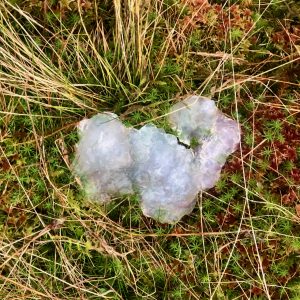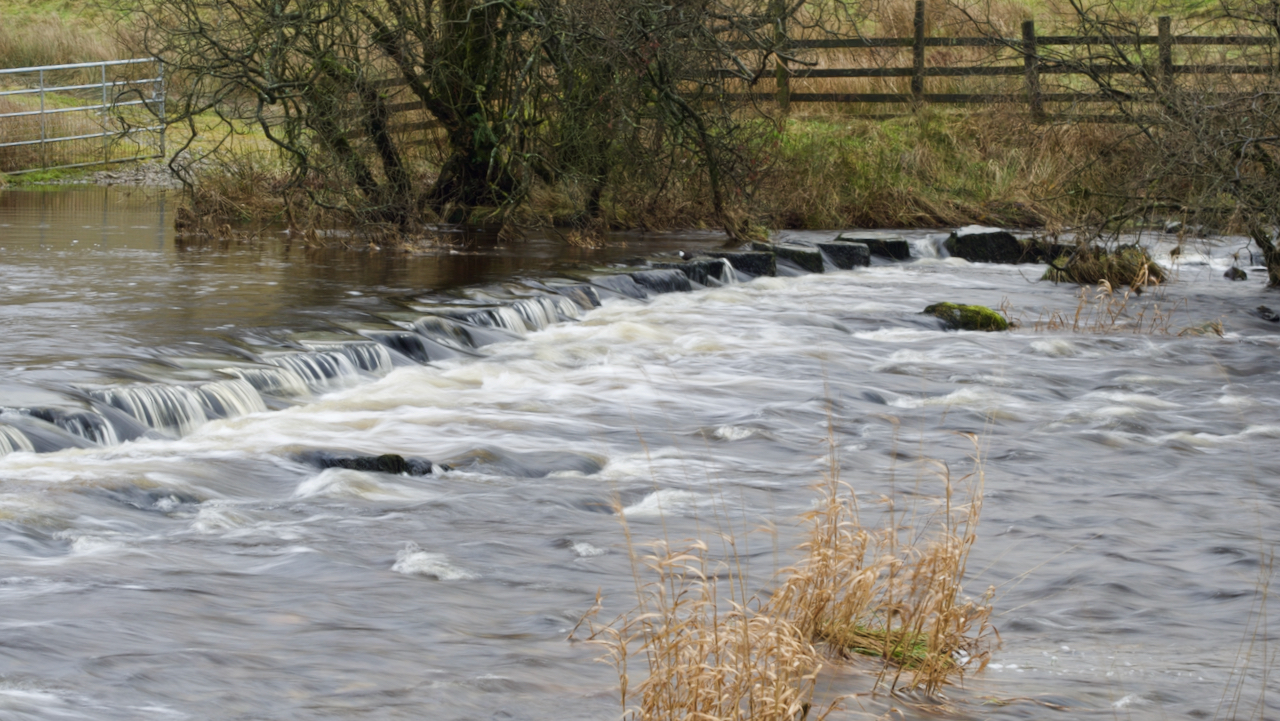
I wasn’t tempted to risk a crossing but was content to watch a dipper hopping across the stones.
The River Doe is quite short, rising near Chapel-le-Dale and becoming the Greta after its confluence with the Twiss at Ingleton.
Soon after these stepping stones the river plunges down a narrow gorge with several waterfalls — which are only veiwable on the payment of an an entrance fee.
A lot of water for a little river, draining the Yorkshire peaks of Whernside and Ingleborough.

One oddity I came across while descending Ingleborough was several masses of a whitish jelly like substance. A sort of like wallpaper paste. There was nothing else around, no sheep, just rough open moorland at 350m asl1above sea level..
There seems to be many explanations as to what this jelly was, but after consulting the oracle that is Wikipedia, I reckon its an algae called Nostoc, or Astromyxin2‘Astromyxin – Exploration Journal’. 2017. Exploration Journal <https://www.explorationjournal.co.uk/tag/astromyxin/> [accessed 1 January 2023], a form of cyanobacteria.
It has many common names which are most interesting: Witches’ butter, Star jelly, Troll’s butter, Spit of moon, Astral jelly and Fallen star3Wikipedia Contributors. 2022. ‘Star Jelly’, Wikipedia (Wikimedia Foundation) <https://en.wikipedia.org/wiki/Star_jelly> [accessed 1 January 2023]4Wikipedia Contributors. 2022. ‘Nostoc’, Wikipedia (Wikimedia Foundation) <https://en.wikipedia.org/wiki/Nostoc> [accessed 1 January 2023]. In Gaelic, it is called Sgeith Rionnaig, ‘Star vomit’5‘The Inverness Courier-September 20, 1895. | Inverness Courier | Friday 20 September 1895 | British Newspaper Archive’. 2023. Britishnewspaperarchive.co.uk <https://www.britishnewspaperarchive.co.uk/viewer/bl/0000446/18950920/044/0003> [accessed 1 January 2023].
Many of these names derive from the suddenness of the jelly’s appearance, resulting in a belief of it apparently falling from the sky during meteor showers.
Two 17th-century works allude to this astral origins6‘Star Jelly | Legendary Dartmoor’. 2016. Legendary Dartmoor <https://www.legendarydartmoor.co.uk/star_jelly.htm> [accessed 1 January 2023]:
“That the Starres eat…that those falling Starres, as some call them, which are found on the earth in the form of a trembling gelly, are their excrement.”
And in Dryden’s play “Œdipus“7‘Where to See Red Snow | Derby Daily Telegraph | Thursday 29 August 1929 | British Newspaper Archive’. 2023. Britishnewspaperarchive.co.uk <https://www.britishnewspaperarchive.co.uk/viewer/bl/0000327/19290829/138/0011> [accessed 1 January 2023]:
“The tapers the gods
The sun and moon run down like waxen globes;
The shooting stars end all in purple jellies.
And chaos is at hand.”
It’s not surprising that such a mysterious and elusive substance would have lore associated with it. In the 14th-century, the jelly was thought a cure for abscesses8Owen, Martyn. 2018. ‘What Is “Star Jelly”? – BiOME Ecology Magazine’, BiOME Ecology Magazine <https://biomeecology.com/nature/2018/02/what-is-star-jelly/> [accessed 1 January 2023].
- 1above sea level.
- 2‘Astromyxin – Exploration Journal’. 2017. Exploration Journal <https://www.explorationjournal.co.uk/tag/astromyxin/> [accessed 1 January 2023]
- 3Wikipedia Contributors. 2022. ‘Star Jelly’, Wikipedia (Wikimedia Foundation) <https://en.wikipedia.org/wiki/Star_jelly> [accessed 1 January 2023]
- 4Wikipedia Contributors. 2022. ‘Nostoc’, Wikipedia (Wikimedia Foundation) <https://en.wikipedia.org/wiki/Nostoc> [accessed 1 January 2023]
- 5‘The Inverness Courier-September 20, 1895. | Inverness Courier | Friday 20 September 1895 | British Newspaper Archive’. 2023. Britishnewspaperarchive.co.uk <https://www.britishnewspaperarchive.co.uk/viewer/bl/0000446/18950920/044/0003> [accessed 1 January 2023]
- 6‘Star Jelly | Legendary Dartmoor’. 2016. Legendary Dartmoor <https://www.legendarydartmoor.co.uk/star_jelly.htm> [accessed 1 January 2023]
- 7‘Where to See Red Snow | Derby Daily Telegraph | Thursday 29 August 1929 | British Newspaper Archive’. 2023. Britishnewspaperarchive.co.uk <https://www.britishnewspaperarchive.co.uk/viewer/bl/0000327/19290829/138/0011> [accessed 1 January 2023]
- 8Owen, Martyn. 2018. ‘What Is “Star Jelly”? – BiOME Ecology Magazine’, BiOME Ecology Magazine <https://biomeecology.com/nature/2018/02/what-is-star-jelly/> [accessed 1 January 2023]

Leave a Reply